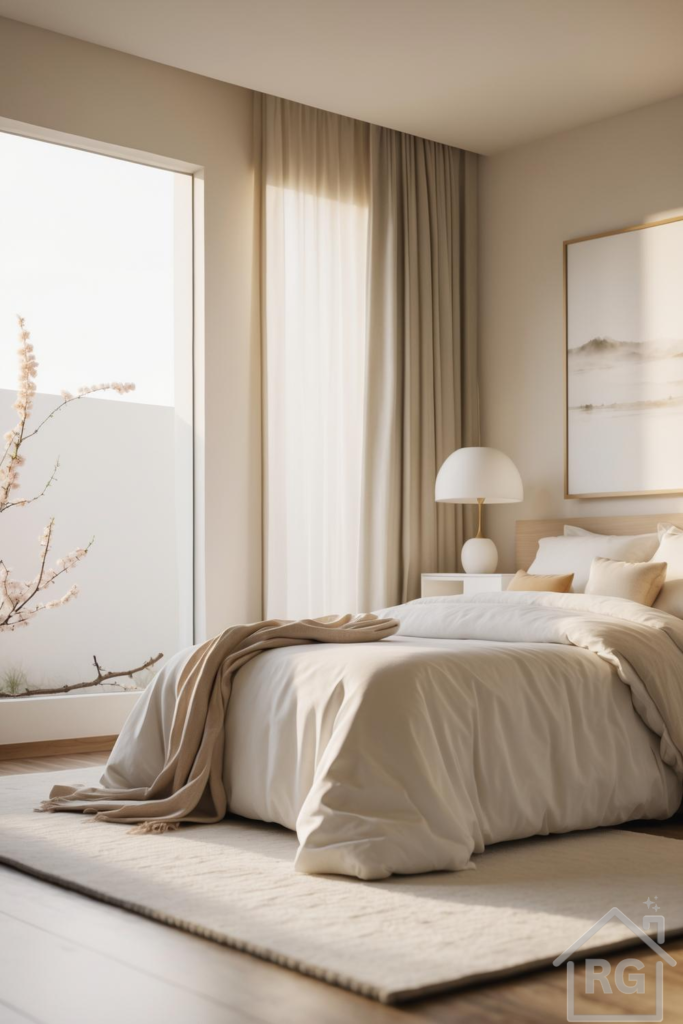
(Color Palette Disclaimer: The color palette referenced here is approximate and may vary based on screen settings and printing methods. Always test paint swatches and fabrics in your space before making final decisions.)
(Affiliate Disclosure: Some of the links in this post may be affiliate links, which means I may earn a small commission if you make a purchase through them—at no extra cost to you. Thank you for supporting my work and helping me continue to provide free content!)
There’s something undeniably comforting about a bedroom bathed in soft neutrals and filled with natural light. Whether you’re decorating a guest room or your own personal haven, a serene, minimalist approach can encourage better rest, reduce stress, and promote an overall sense of well-being. In this blog post, we’ll explore how to create a tranquil bedroom using neutral tones, streamlined furnishings, and carefully chosen accents that harmonize beautifully.
Understanding the Power of Neutral Tones
Neutral shades like cream, beige, soft gray, and off-white act as a calming canvas for the rest of your decor. These colors reflect light effectively, making even smaller rooms feel more open and airy. Moreover, neutrals tend to pair seamlessly with other tones, giving you the flexibility to introduce subtle pops of color or seasonal accents without clashing.
When selecting paint or fabrics, look for hues that have warm undertones to maintain a cozy vibe. Cooler neutrals can still be inviting, but they may require more attention to lighting and texture to keep the space from feeling too stark.
Choosing Minimal yet Functional Furniture
A clutter-free environment helps set the stage for relaxation. Begin by selecting key furniture pieces that are both functional and visually appealing. A low-profile bed frame with clean lines instantly contributes to a streamlined look, while a simple nightstand offers practical storage without overwhelming the room. If you have extra space, consider a small bench or accent chair in neutral upholstery—these elements can enhance comfort while still maintaining a cohesive design.
In a truly minimalist setting, each piece should serve a purpose. Steer clear of bulky furniture or ornate details that detract from the calm you’re trying to create. Instead, focus on subtle shapes and understated silhouettes that let the neutral color scheme shine.
Layering Textures for Warmth
One potential pitfall of a neutral palette is that it can appear flat if you don’t introduce enough texture. Layering different fabrics and finishes helps bring depth to the space. Consider plush bedding, a soft area rug, or woven throws in complementary shades. Natural materials like light wood or bamboo also work beautifully in neutral rooms, adding a subtle, organic element to the overall look.
- Bedding: Look for crisp cotton sheets paired with a plush duvet or comforter in an off-white or cream hue. A lightweight knit blanket can provide an extra layer of coziness.
- Rugs: A soft rug underfoot is essential for a welcoming feel, especially if you have hardwood or tile floors. Choose a low-pile option for easy maintenance and a clean aesthetic.
- Window Treatments: Sheer curtains filter sunlight, creating a gentle glow throughout the day. For added privacy or light control, pair them with simple blinds or heavier drapes in a similar neutral tone.
Bringing in Natural Light
Nothing elevates a space like abundant natural light. Large windows or sliding doors can brighten up a neutral bedroom, allowing you to take advantage of the day’s natural rhythms. If privacy is a concern, consider sheer curtains or light-filtering blinds rather than heavy drapes that block out the sun. Reflective surfaces, like a well-placed mirror, can also help distribute light more evenly, making the room feel more spacious.
Incorporating Subtle Accents
While the goal is a calming palette, small touches of color or nature-inspired elements can prevent the room from feeling too monochromatic. A vase of fresh or dried flowers, a single piece of artwork, or a potted plant can serve as focal points without detracting from the overall serenity. If you prefer an all-neutral approach, play with varying shades of the same hue—for instance, layering cream, taupe, and beige in your textiles and accessories.
Lighting & Ambiance
Aside from natural light, ambient and task lighting are key to creating a restful atmosphere. A soft overhead fixture can illuminate the entire space, while table lamps on either side of the bed provide gentle illumination for reading or winding down. Dimmer switches are a great option for adjusting brightness to suit your mood, and warm, white bulbs (around 2700K–3000K) typically feel more relaxing than cooler daylight bulbs.
Maintaining Your Serene Space
Once you’ve created a tranquil bedroom, a little upkeep goes a long way. Regularly declutter surfaces like nightstands or dressers, and keep the floor clear of unnecessary items. Make your bed each morning to set a positive tone for the day—a small habit that keeps the space looking polished and inviting. If you want to change things up seasonally, try swapping out throw blankets or accent pillows for a fresh twist without sacrificing the room’s neutral harmony.
A calm, neutral-toned bedroom can offer a welcome retreat from the stresses of daily life. By carefully curating your furniture, layering textures, and letting in plenty of natural light, you’ll create an environment that fosters rest and relaxation. Add a few personal accents—like a favorite artwork or a comforting throw—to reflect your style, and you’ll have a serene sanctuary that remains inviting for years to come.
